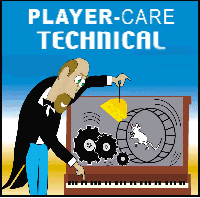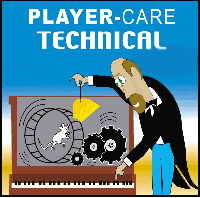
|

|

|

|

|

|
| Home | Manuals | Supplies | Search | Consult | Contact | Testing | Service |


Rebuilding the Old Player By Charles E. Richardson, North Andover, Mass.
|
|
During the past year or so, player men have been coming in contact with many players which have become useless to their owners, principally, perhaps, because of neglect, although, as we all know, the players of some years ago were not made of the same materials nor worked out on such accurate principles as they are today. But whatever the cause, the fact remains that here and there are quite a number of players which need to be put in shape. Of course, tuners and player men know the proper way to regulate and adjust a player which has gotten out of order from ordinary usage, etc., but many player men hesitate to attempt to restore a player which is completely useless and which needs rebuilding. I have found that in many cases, these old players can be rebuilt to the satisfaction of the owners and to the profit of the player men. One must use caution, however, in estimating the work and the cost. Many times it is almost impossible to make an accurate estimate, in which case it is better to take the job by the hour or day. If the owner insists on a price, then the only thing one can do is to figure high enough to allow a good margin for any unforeseen work that may arise. Many of the double valve type players can be rebuilt almost as good as new, but one must be careful when submitting an estimate as new parts cannot be obtained for certain old types. In such a case it is better to figure on installing a new action of a modern type which can be bought at a reasonable price. When rebuilding an action, I generally begin by completely regulating the piano and tightening the player action. Any parts which need mending I repair, of course. When everything has been regulated, I test for snugness and tightness. I feel that if I can get the action tight, the job is half done. With a very old action, however, the chances are that this cannot be done at the first attempt. The leaks can be located by putting on a blank roll, setting the tempo at zero and treadling hard. It helps to have some one else do the treadling while one hunts for the hissing leaks. The bottom action, of course, requires attention first. I generally look for leaks in the cloths on the exhausters and the equalizers and around the corners in other pneumatics where the creases come. Sometimes it is impossible to see the leaky places but one can tell by the sound and by the feel of the treadles that there are leaks. I have found by removing an exhauster, or whatever else seems to be leaky, placing it on the bench and putting an electric light bulb inside, that leaky or porous cloth will show, when other methods have failed to disclose it. At the same time I always examine the packing leathers, flap valves, etc. Of course, porous cloth must be replaced if a good job is desired. I carefully measure the widest part and the length of the old cloth before removing it. Some repair men leave a narrow strip of the old cloth at the widest end so that the right width may be assured, but I have never found this necessary. Triangular pieces of cardboard where the creases come will be found in large pneumatics, such as exhausters, etc., which serve as linings. If one is careful, these can be saved, and by accurate measuring may be replaced on the new cloth. I have never found it necessary to use any new linings, provided I was careful to crease the new cloth by hand after it was in place. With the cloth off, I examine the boards and the hinge cloths for leaks. If I find any porous places, I shellac them. After cutting the new cloth the same width as the old and long enough to go around the outside edges of the boards, I clean off all the old glue, etc., from the edges, then place the boards in a vise, hinge side down, with a piece of wood between to hold them open just the desired width, and begin by putting hot and newly made glue along the wide end, being careful to keep the glue away from the inside edges of the boards so that when finished there may be no lumps of hard glue to dig into the folding cloth at the edges. I now fold the cloth lengthwise into two equal parts to find the center, place this middle crease in the middle of the top where the edges are glued and then press down hard, using a flat piece of wood and always rubbing outward, in order to keep the glue away from the inner edges. I then, glue one side in the same way, letting the edges of the cloth overlap, it being the same width, of course, as the ends. I press hard the same as before and am careful of the corners. I take the board out of the vise, remove the wooden plug and glue the other side. I then stand it on its wide end and glue the hinge end, lapping over the ends of the cloth. I must work quickly throughout all of this, for after getting thus far I dip a cloth in warm water, wet all the edges and go over all the glued edges again, carefully rubbing down from the inside out. After getting all of the edges snug and trimming off any surplus cloth, I cut out and glue a piece of cloth over the ends of the hinges. Sometimes a few tacks here will also help. Then I lay the work away to allow the glue to set. I cover all pneumatics, large or small, in the same way, using the proper weight of cloth in each instance. It is wonderful how nice and snug a bottom action will be after complete recovering has been done. Upon testing the bottom action, if it is found snug and no leaks are present, of course recovering will be unnecessary. At times new springs on the exhausters and equalizers give new pep to the treadling, and it is always well to look over all springs and replace with new ones where necessary. Sometimes after complete regulating and overhauling the top action does not come up snug, or if it does there seems to be leakage when playing. In double valve actions the secondary valves frequently are at fault. They get hard around the exhaust seats from dampness. I have found that installing a new set of secondary valves will remedy this condition. By sending one of the valves as a sample to the factory where the action was made, a new set may be obtained. My experience has been that it is much better to send the valve and the pouch board and let the factory install the new set and otherwise repair it. Time and trouble can be saved in this way, as the factory can do this work much cheaper and more quickly than the tuner can, unless perchance the tuner has plenty of spare time! Even then I think it is better to let the factory do the work. It is very seldom that the primary valves need to be renewed, only here and there where one or two may be broken. Of course, the tracking device and motor have to be looked over. New tubings to the "loud" and "soft" pedal pneumatics and "silencer" may be necessary. Sometimes even new parts will have to be placed in the transmission. In a nutshell, the idea is to go over very carefully each and every part and replace, renew or repair any part which may be defective. Naturally, the player man must thoroughly understand the theory and operation of the player piano mechanism because there will be many times when certain devices will have to be "doped out." In nearly every case where I have installed new valves, new boards and new packing leather, the action came out like new. In one case recently, the owner told me the player played better than when it was new. I think perhaps this was true, because after years of experience in the making of them, the valves used today are better than they formerly were. In the double valve type, which is similar to the modern type, I have had fine success in overhauling 65-note players and changing to 88-note. I feel that there is a large field for the player man who goes after the work of rebuilding useless players of the old types if he will carefully estimate the work. This is important. I try to be careful not to figure on any action the manufacturer of which is no longer in business, as in most cases new parts will be needed. But where new parts may be obtained, especially the valves, any action, no matter how badly out of order it may be, can be rebuilt almost like new. ------------------------------------------------------------- |
|
Since "Player-Care" is an internet business, I prefer that we correspond via E-Mail (click here to fill out the 'Request Form'). However, if I'm not in the middle of some other activity, you can reach me at 732-840-8787. But please understand that during the hours from 8AM-5PM EST (Mon-Sat), I'm generally quite busy. So, I probably won't answer the phone. If you get the answering machine, please leave a detailed message stating the reason for your call. Also, repeat your name and phone number clearly and distinctly. By necessity, I prioritize everything in my life. And, if you call and just leave your name and number, and ask me to call you back, it might be a day or two before I return your call. Why? Because I don't know why you want me to call and I might not be prepared to assist you in an effective and efficient manner. If you leave me an E-Mail address (which I prefer), spell it out phonetically. The more you do to help me, the more I can help you in return. Don't rush. You have four minutes to record your message. |
|
407 19th Ave, Brick, NJ, 08724 Phone Number 732-840-8787 |